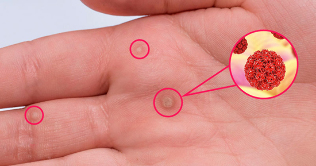
In this article we will cover the following:
- What are papillomas;
- What is the reason for their creation.
- common places in men and women;
- typical papillomas.
Papillomas are a good sign localized in the skin and mucous membranes. They are caused by the human papillomavirus (HPV), which is transmitted in various ways. The appearance of the forms depends on the type of virus they cause.
Transmission paths
Human papillomavirus:
- During sexual intercourse, including anal, oral-genital organs.
- Home. The microorganism is able to exist on personal belongings, personal hygiene items, infected towels. It easily penetrates the skin with scratches and abrasions.
- During childbirth.
If the virus is transmitted from one part of the body to another, it is possible to become infected automatically if shaving or hair loss occurs in general.
The incubation period (from the onset of HPV to the onset of pathological symptoms) is from a few weeks to several years.
Papillomas in the body are more common in cases of illness accompanied by decreased immunity, pregnancy, alcohol abuse, psycho-emotional stress, hypothermia. The prevalence of these phenomena is the same in men and women.
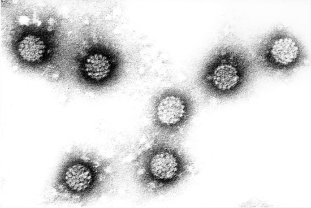
Human papillomavirus: types
Depending on the risk of skin oncological pathology, mucous papillomaviruses belong to the following groups:
- Low oncogenic risk (HPV types 3, 6, 11, 13, 32, 34, 72, 73, 40–44, 51, 61).
- Moderate oncogenic risk (HPV types 52, 56, 58, 30, 35, 45).
- The risk of developing malignant processes (HPV types 50, 59, 16, 18, 64, 68, 70, 31, 33, 39) is high.
Microorganisms with a low risk of cancer cause malignant growths on the skin and mucous membranes.
Types of papillomas
Simple
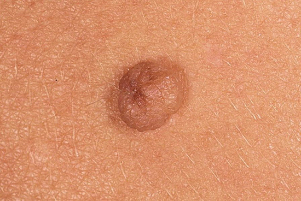
They are also called vulgar, ordinary. Such growths are mostly caused by HPV type 26-29, 77, 63, 41.
Wrinkles and burning sensations appear on any part of the body. Then the growth of a spherical formation is noted, the surface gradually becomes rougher. First, the tumor is colored, then darkens. The size of the papilloma on the body is from 1 mm to cm
These neoplasms are many. In the latter case, the daughter's small papillomas are located around the mother, who is the first to form, usually the largest.Their localization is the back of the hands, fingers, the spaces between them, the jaw area, the edges of the lips. There are such papillomas on the neck. The child's knees are affected because children often crawl and become infected with small skin lesions.
Plantar
People with this form become infected with HPV types 1, 2, and 4. Growth is similar to dry bells, but has a number of characteristic differences.
The skin sample is protected in the calluses, not on the surface of the papillomas, the latter is smooth. Papillomavirus formation is painful, and the unpleasant sensations when wearing tight shoes intensify. Inside the papilloma, black dots that are not in the calluses appear.
The most common neoplasms in children are sometimes self-destructive. Sometimes small bubbles appear around the neoplasm. The latter turn into new papillomas over time.
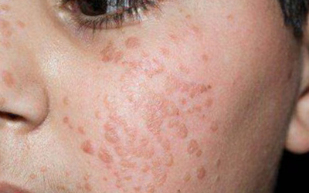
Straight papillomas
Round, elongated, oval growth grows 1-2 millimeters above the level of the skin. Flat papillomas are localized around the mouth, face and upper half of the body. Occasionally there are papillomas on the neck.
There are reports of papilloma near the labia, cervix in girls, penis in men, rectum, anus. These compounds are located in groups and merge with each other. Fleshy papillomas, sometimes darker than the rest of the skin, are caused by 10, 49, or 28 types of papillomavirus.
Threaded
When people see small papillomas on the neck, the growths often look like thread. The second name of the form isacrocordus. The latter cause 2, 7 types of HPV.
Initially, papillomas in the neck appear as small yellowish seals, then grow, become rough, elongated, rounded, and take the form of a rope. A distinctive feature of a similar papilloma in the neck is a thin leg.
Acrocordus is more common in men and women over 40 years of age. Growth also occurs on the skin of the upper eyelids, armpits, mammary glands, and the intimate area.
Assigned
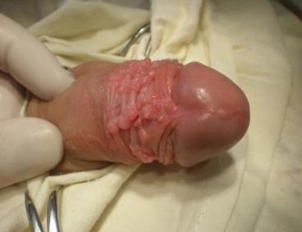
Form data is calledsneezes,, and is caused by 6, 11, 44, 42, 54, 51, 55, 89 types of human papillomavirus in women and men.
Condylomata are fleshy, small, solitary, multiple growths localized around the anus and in the female and male genitals. There are papillomas in the vagina, labia minora, cervix. In men, condylomata are located in the bladder, at the head of the penis, inside the urethra.
The individual elements sometimes combine with each other, forming a tumor-like shape that looks like a rooster's comb or cauliflower. Neoplasms are characterized by very rapid growth, and after a few hours a large lesion may appear.
There is a recurring course in pathology. Infectious sexually transmitted infections of the urogenital tract (eg, chlamydia, gonorrhea, mycoplasmosis) are more severe.
Condyloma in the cervix, especially inside the cervical canal, is the most dangerous during pregnancy. Hormonal changes stimulate rapid growth, followed by tissue breakdown and secondary infections.
Papillomas in the mouth, larynx
Their appearance is associated with the activity of 6, 7, 11, 72, 73, 57, 32 types of papillomaviruses. The shapes are round in shape with a thin or wide base. The mucous membrane around them becomes pale pink without visible pathological changes. The surface of the growths is pale pink, white.
Neoplasms are solitary, very, painless when solid. In the lower part of the oral cavity, behind the tongue, hard, soft palate, laryngeal mucosa, size from 2 mm to 2 cm.
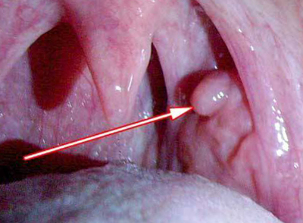
Excessive growth of the oral mucosa darkens as a result of bleeding. In the presence of such a disease, the state of health does not deteriorate, the oral cavity opens freely.
In adults, single growths are present in the soft palate, tonsils, glottis, the presence of a foreign body, coughing, hoarseness. If the lesions increase, these symptoms worsen.
Pathological growths in children are often bilateral, their occurrence is accompanied by the following symptoms:
- Difficulty in breathing, exhalation, after physical exertion, and then at complete rest.
- Cough after hard work.
- Choking attacks withstenosis of the abdominal cavity(pathological narrowing that prevents air from entering the lower respiratory tract).
The appearance of different papillomas on the outside is associated with different types of HPV infection. You should consult a doctor to remove neoplasms. This should be done as soon as possible if there are many papillomas, if they grow rapidly, cause discomfort and are constantly injured.














































































